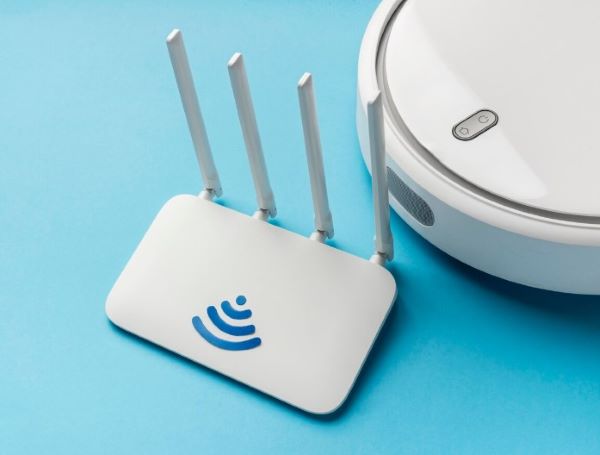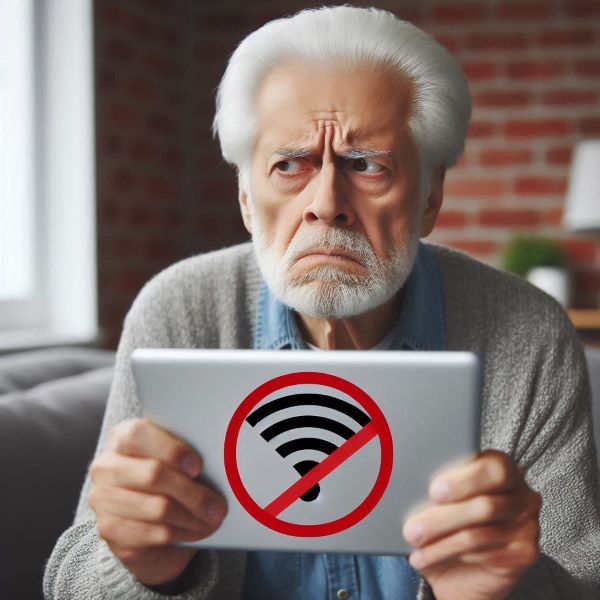
A good Wi-Fi connection enables you, as an older adult, to do many things on the Internet, including chatting with family on video calls, reading the news online, watching your favorite shows on YouTube, and more.
However, setting up Wi-Fi can be challenging for newbies to the process. To help you, we have written this step-by-step guide in plain language.
By the end of this guide, you will know:
- What Wi‑Fi is and why it’s useful.
- How to Set It Up Safely and Confidently at Home.
- Required Equipment and What You Don’t Need.
- How to Stay Secure and Avoid Common Issues.
No technical background is required, so let’s get started.
What You Need Before You Start.
You will need a few items to step up Wi‑Fi at home, including:
An Internet Service Provider (ISP).
First, ensure you have an account with the Internet Service Provider in your area. The common ones in the United States include:
- Xfinity / Comcast.
- AT&T.
- Spectrum.
- Verizon.
- Local or regional providers.
Tip: Inquire about basic home internet plans and whether they offer special rates for seniors.
A Modem and a Wi‑Fi Router.
Installing Wi‑Fi at home requires this equipment:
- A modem to connect to the internet provider.
- A router that distributes the internet signal throughout your home via Wi-Fi.
Check with your Internet provider to see if they offer a modem/router combo, which can be easier to use or compatible models if buying your equipment.
A Power Outlet and Cable Connection.
- A modem typically needs a power source to connect to a cable or phone line.
- Place the router in a central location within your home for optimal coverage.
- You will also need a laptop, tablet, or smartphone to test your Wi‑Fi or use it.
==>Check out our guide on Choosing the Right Laptop for Seniors.
A Wi‑Fi Network Name and Password.
Your Internet provider will supply the router with a default network name (SSID) and password printed on a label to connect your devices.
Step-by-Step Wi‑Fi Setup Process.
Now that you have gathered the necessary equipment, follow these simple, detailed steps to set up your home Wi‑Fi.
Step 1: Connect Your Modem.
The modem brings the internet signal into your home from your Internet Service Provider (ISP).
You won’t be able to go online without this connection.
What to Do:
- Plug one end of the coaxial cable (round cable) into the wall jack or cable port.
- Connect the other end to the modem.
- Use the power adapter to plug the modem into a nearby electrical outlet.
Then wait 1–2 minutes for the network to establish a connection. A small light indicates that the Wi-Fi is connected to the Internet.
Step 2: Connect the Router (if it’s separate).
A router creates the Wi-Fi signal in your home and sends the internet connection to your devices (such as tablets, phones, or laptops) without the need for wires.
What to Do:
- Take the Ethernet cable (looks like a wide phone cord) that came with the router.
- Plug one end into the modem.
- And the other end into the router’s WAN or Internet port (usually a different color or labeled).
- Then plug the router’s power adapter into the wall.
Tip: Skip this step if you received a modem and router combo.

Step 3: Locate Your Wi‑Fi Name and Password.
This step enables your router to detect which Wi‑Fi signal to join and protects your connection from outsiders.
Most routers come with a sticker that includes:
- Network Name (SSID) appears when searching for Wi-Fi.
- Wi‑Fi Password (Key) is the code you enter to connect securely.
You can find this information on the back or underside of the router. Please write it down on a notecard and place it in a convenient location.
Step 4: Connect Your Device to Wi‑Fi.
Follow these steps on your laptop, smartphone, or tablet:
On Android:
- Open Settings > Tap Network and Internet or Wi‑Fi.
- Wait for the list to load, then tap your network name.
- Enter the password, then tap Connect.
On iPhone:
- Open Settings > Tap Wi‑Fi.
- Tap your network name.
- Enter the Wi‑Fi password, then tap Join.
On Windows PC:
- Click the Wi‑Fi icon on the taskbar (bottom right).
- Select your network, click Connect, and enter the password.
You don’t need to re-enter your password every time to connect to the Wi-Fi; the device usually remembers your credentials.
Step 5: Confirm Your Connection Is Working.
- Open a browser and type in www.google.com.
- Your Wi‑Fi is working if the page loads.
Congratulations! You are officially connected to the Internet at home.
Bonus Tip: Change Your Wi‑Fi Name or Password (Optional): Most routers allow you to log in and change your network name and password to make it easier to remember.
Still, you can keep the default settings if you are comfortable with the process.
Troubleshooting Common Wi‑Fi Issues.
This section helps seniors (and their caregivers) understand and resolve common problems without technical skills when Wi-Fi isn’t working as expected despite a correct setup.
No Internet Connection.
This happens when you connect to Wi‑Fi, but websites or videos won’t load.
What to Try:
- Check the modem/router lights – Unplug both the modem and router if they’re off or blinking red.
- Please wait 30 seconds, then plug them back in.
- Restart your device (phone, computer, or tablet).
- Ask your internet service provider if there’s an outage in your area.
Tip: Internet providers typically offer support apps or hotlines that enable you to check the outage status quickly.

Can’t Find Your Wi‑Fi Network.
You will notice that your device doesn’t display your network name (SSID) in the Wi-Fi list.
What to Do:
- Check if you have plugged in and turned on the router.
- Wait 1–2 minutes for the signal to appear.
- Restart the router if the issue persists.
Related Content: A Simple Guide to Basic Computer Terms for Older Adults.
Wi‑Fi Password Not Working.
Try these tips if you type the password, but your device says it’s incorrect.
- Double-check for typos, especially in the uppercase and lowercase letters.
- Check if the name of the connected network matches the one printed on your router.
- Press the small reset button located on the back of the router to reset it to its factory settings if the issue persists.
- And use the default Wi‑Fi name and password from the sticker again.
Note: Resetting the router erases any changes made by a technician.
Very Slow Wi‑Fi.
A very slow Wi-Fi connection can cause call freezing, slow page loading, or video buffering.
Use these tips to resolve the issue:
- Move closer to the router.
- Limit the number of devices connected to Wi‑Fi at the same time.
- Restart the router once a week to maintain its performance.
- Check your plan’s speed with your provider to determine if they can upgrade it.
Still Having Trouble?
Consider asking for help from a family member or a tech-savvy friend if you still have trouble, or check with your internet provider to see if they offer free or low-cost technical support for seniors. Remember to write down the issue to explain when you ask for help.
Wi‑Fi Safety Tips for Seniors.
Find below how to make your connection private, secure, and reliable without needing to be a tech expert.
Change the Default Wi‑Fi Password.
The router uses a default password that hackers can detect when you first set up your internet connection. Still, you can change its settings to make it more secure.
How to do it:
- Open a browser and type the IP address printed on the back of the router (usually
192.168.0.1or192.168.1.1). - Log in using the default username and password also found on the router.
- Check the Wireless Settings section and choose a new, strong password (a mix of easy-to-remember but hard-to-guess letters and numbers.
- Write your password down in a notebook and store it safely.
Name Your Network Wisely (SSID)
Using your real name, address, or apartment number can expose your personal information to anyone in the vicinity.
Avoid easy-to-guess names, such as “MarySmith_WiFi” or “101_MainStreet_WiFi,” and opt for neutral names, like “HomeNet_2025” or “Sunshine_Wireless.”
You can also hide the SSID, but be cautious, as it can make it harder for you to connect new devices later.
Use a Secure Wi‑Fi Encryption Type.
Wi-Fi encryption scrambles the data you send online, making it harder for people to steal your information easily.
- Go to your router settings as suggested in Step 1.
- Under security options, select WPA3 (if available) or WPA2 (avoid selecting outdated options like WEP).
- Save your settings and restart the router.

Avoid Giving Out Your Wi‑Fi Password.
The more people who have access to your password, the more vulnerable it becomes.
Best practices:
- Allow only trusted family or visitors to access your Wi-Fi password.
- Set up a “Guest Network” through your router settings for individuals who need temporary access.
Update Your Devices and Router.
Updates fix security bugs and improve performance, so consider doing them regularly.
Enable updates on your devices under “Software Update” and periodically check your router brand’s website for available firmware updates.
Avoid Fake Wi‑Fi Networks.
Be cautious when using public Wi-Fi connections, as hackers can set up fake networks to steal your data.
This is how you stay safe:
- Avoid using public Wi-Fi for banking, shopping, or entering passwords.
- Ask a family member or contact technical support for help setting up a VPN (Virtual Private Network) if needed.
Frequently Asked Questions (FAQs) About Setting Up Home Wi‑Fi.
Seniors and caregivers often ask the following questions when setting up and maintaining a secure Wi‑Fi network at home.
Do I need internet service to set up Wi‑Fi at home?
Wi‑Fi shares the internet connection received from an Internet Service Provider (ISP), such as Xfinity, AT&T, or Spectrum.
Once a technician installs the service, they will usually provide a modem and a Wi-Fi router, such as Google’s, or a device that combines both.
Contact a local provider or ask a family member for help in choosing a reliable plan if you’re unsure whether you have internet service yet.
Can I install Wi‑Fi without technical experience?
Most routers now come with step-by-step instructions, or even QR codes, to make setup easier. Still, you can ask a family member, neighbor, or even hire a local computer technician for a quick setup visit if you’re unsure.
What if I forget my Wi‑Fi password?
- Check the back or bottom of your router to see where the Internet service provider labeled the original password.
- Log in to your router settings to reset the password or ask someone ro do it for you.
- And write it down in a labeled notebook for future reference.
How can I tell if my Wi‑Fi is secure?
A secure Wi-Fi network requires a password to establish a connection. Use WPA2 or WPA3 encryption, which can be found in your router settings, and keep it private.
Don’t hesitate to ask a trusted friend or relative to review your router settings with you if you’re having trouble understanding the process.
Can I have Wi‑Fi in my whole house, or just one room?
Wi-Fi signals typically cover most homes, but the strength depends on factors such as the size of your home and whether you have placed your router optimally at the center of the house.
The signals may also increase or decrease depending on whether you have thick walls or multiple floors. Use a Wi‑Fi extender to stretch the signal farther if you have weak signals in some rooms.
Is it safe to use Wi‑Fi for online banking and shopping?
It depends on whether you have a secure Wi‑Fi connection and you browse trusted websites.
- Secure websites start with https:// (the “s” means secure).
- Don’t enter passwords or credit card info on public Wi‑Fi.
- Use strong passwords and regularly update your device’s software.
- Never share your banking password, even with friends or tech support.
Getting Comfortable With Home Wi-Fi.
Setting up Wi-Fi at home can be challenging at first. Still, the outlined steps make the process straightforward for installing a reliable internet connection and browsing the Internet safely.
Ask for help from family, tech-savvy friends, or local professionals if you get stuck or find the process intimidating or stressful.
You can learn affiliate marketing through a beginner-friendly training program like the Wealthy Affiliate Platform, which teaches you how to build a website, create content, and earn a sustainable income online over time.
You can learn affiliate marketing through a beginner-friendly platform like Wealthy Affiliate, which teaches you how to build a website, create content, and earn a sustainable income online over time.

